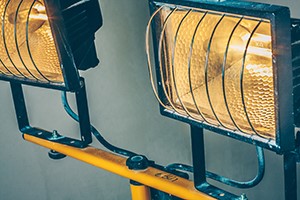Four Considerations when Choosing Construction Lighting (and Other Options You Might Not Have Considered)

Portable temporary lighting is crucial to ensure safety on construction sites. Injuries and accidents increase during nighttime building projects when visibility is limited, and these risks increase on sites with environmental hazards, like falling objects or nearby car traffic. Reliable lighting not only allows workers to spot dangers more readily, but also increases working hours and job efficiency so you can meet crucial deadlines.
Many types of lights and setups are available, and your considerations may vary based on the worksite or job requirements.
- Portability: Some light options can be moved around a jobsite or to other sites easily while others are meant for long-term, stationary work. This may add additional considerations, such as terrain adaptability or tire maintenance and replacement.
- Mast Height: This helps determine the intensity of light and area of illumination, with taller towers covering larger areas. 30’ masts are common on construction projects.
- Lighting Type: Metal halide lamps are a common and affordable option, but LED lights are increasingly popular for their longevity, energy efficiency, and brightness. You may have uses for both focused spotlights with a narrow beam of less than 45°, or wide-ranging floodlights whose beams spread nearly 120°.
- Power Source and Output: Towers can be powered by built-in diesel generators, which have high fuel consumption but are reliable in remote locations. Some towers are electric only and can be plugged into an external power source, often with modular connectivity that allows multiple towers to run off the same source. Others use rechargeable hydrogen or solar cells, zero-emission choices that operate quietly and function particularly well with lighter, cart-mounted towers.
Lighting Options
With these considerations in mind, you can determine what structure works best for your site, job length, and other needs.
Portable Lighting Towers: These tall, freestanding structures have multiple high-wattage light fixtures and offer a wide field of illumination, thanks to a telescoping mast that can be raised or lowered. Their versatility is a massive advantage, as they can be cart-mounted and moved around a jobsite by hand or trailer-mounted and pulled along roads and highways for easier movement between jobsites. They can be powered by diesel generator, rechargeable battery system, hydrogen fuel cell, or solar cells.
Temporary Lighting Towers and Pole-Mounted Lights: These standing lights are similar to portable towers in that they have multiple lights mounted to a mast, with numerous directional options. Sometimes they utilize a tripod or concrete base to stand freely and sometimes they’re skid-mounted for easier movement. They’re often lighter and can be collapsible for convenient storage and transport, and many shorter ones are available for interior work.
Balloon Lights: When brightness impedes work, a translucent fabric balloon can be mounted on a tower to diffuse light and reduce glare and shadow. This allows for reflective 360° lighting that operates quietly and without emissions. Balloon lights can be freestanding, mounted onto mobile construction equipment, or overlaid onto traditional tower lighting.
Other Lights: There are many types of smaller lights with versatile applications and mounting formats that may benefit your construction job, including hanging lights, string lights, magnetic lights, and loading dock lights for work inside trailers.



